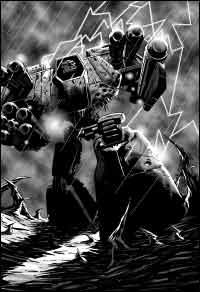The following rules were written by Gav Thorpe, and restore Imperial Titans to their rightful place as the kings of the Epic battlefield. They have a debt to my own venerable Adeptus Titanicus rules (thus the title), but I have to say they are much better than my earlier effort. Truly the student now exceeds the master... But I digress. Gav’s rules make Titans a much more formidable foe, and makes them much more interesting to use as well. You’ll find that you can now have perfectly enjoyable games just using Titans, without any vehicles or infantry taking part, and such ‘Titan vs Titan’ games provide great introduction to Epic for new players. Future issues of Epic magazine will expand these rules so that they cover all of the different kinds of war engines found in Epic. Until we do that, however, other war engines carry on using the normal Epic rules. In the fullness of time we will combine all of the Adeptus Titanicus II rules together into an official supplement for the Epic 40,000 game system. Before going onto the rules proper, it’s important for me to note that these rules are not optional. They are ‘new rules’ for Epic 40,000 and replace those for Titans in the Epic 40,000 rulebook. This said, springing them on an opponent without prior warning is completely out of order and not at all the kind of conduct we expect from Epic players – so just don’t do it, OK! However, assuming both you and your opponent know of the rules, then you really should use them. If your opponent doesn’t have a copy of the rules, then the ‘Firepower’ section later on in this magazine lists how he (or she!) can get hold of them at minimal cost. But enough of my ramblings and conjunctions. I’ll now hand you over to Gav Thorpe... For ten thousand years the Imperium has warred on its enemies. War is the universal state of man; peace is only a brief time of preparation for further fighting. Alien races strike at the Imperium’s frontier systems. Rebellion and treachery are commonplace on thousands of colonised worlds. The Traitor Legions, confined for millennia in the desolate Eye Of Terror, chafe and probe at the Imperium. And in the eddies and storms of warp space, forces and creatures of darkness are stirring. The wars have no end, for that would be the end of Man. In its perils Mankind has one guide: the Emperor. In his care rests the fate of humanity. At his right and left hands are the weapon and shield of Mankind, the forces of the Imperium – the mighty Titans of the Adeptus Titanicus. Using the rules below you can re-create some of the greatest Titan battles of Imperial history. The rules update and expand the rules for Titans in the Epic 40,000 rulebook. In order to use them you will need a copy of the Epic rules, and at least two Imperial Titan models (one for each player). Read the rules through carefully, and then have a practice game just using one Titan per side. After playing a couple games like this you will be ready to expand your force and field a Titan battle group on each side, or add supporting detachments of vehicles and infantry. The important thing is to build up slowly rather than diving in the deep end. With time and practice the rules will become second nature and you will easily be able to incorporate them into any size of Epic game that you play. Except where modified below the normal Epic 40,000 game rules apply. VERY IMPORTANT: The following rules are written assuming that games will pit Titan’s against Titan’s, without any other types of unit being involved. At the end of the rules you will find a section that explains how Titans ‘interact’ with (i.e. shoot and stomp!) other types of Epic unit. We’ve lumped all these rules together like this for the sake of simplicity and to avoid repetition, as otherwise the main rules would be littered with ‘ifs, buts and maybes’. |

 Titans
are the supreme fighting machines of the Imperium. They are giants with
skins of adamantium, protected by fields of almost impenetrable energy,
crewed by devoted warriors and armed with the mightiest weapons Imperial
tech-priests can devise. Through the Imperium and beyond nothing inspires
the same kind of awe and fear.
Titans
are the supreme fighting machines of the Imperium. They are giants with
skins of adamantium, protected by fields of almost impenetrable energy,
crewed by devoted warriors and armed with the mightiest weapons Imperial
tech-priests can devise. Through the Imperium and beyond nothing inspires
the same kind of awe and fear.